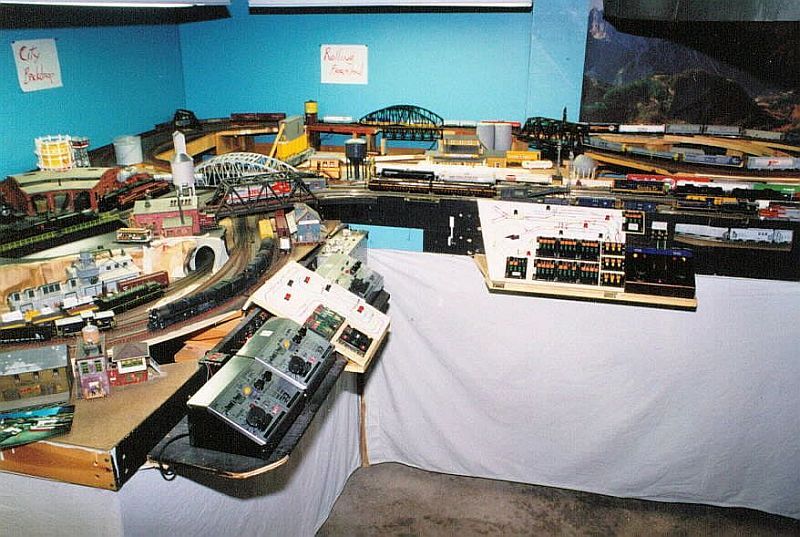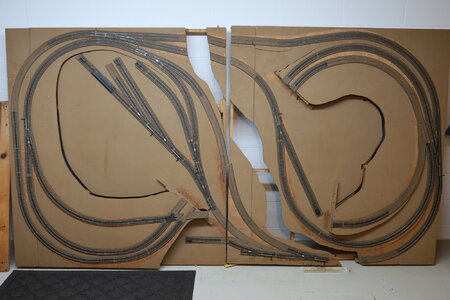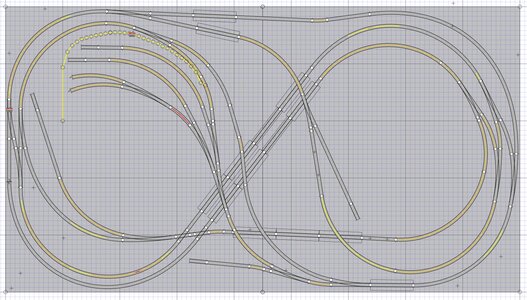GandG_North
Member
Hi everyone. 40 some years ago I built the benchwork and put down the cork roadbed and HO Atlas Customline track, for the Granite Gorge and Northern railway. Then stopped. I've only ever run 1 loco on just a very small part of it for about 5 minutes. Other than that, all I've done with it is moved it whenever we moved.
Seems to be a common theme, but I'm now kinda retired and bored and was looking for something to do since here in Ohio it is winter and my favorite hobby, fishing, is on hold until April, when I can get my pontoon boat back on the lake.
After watching many model railroading YouTube videos (thank you, Jerry Hensler et al), I have the bug again. I've also discovered that this is not necessarily an inexpensive hobby, with DCC now an option (back when I built my layout, it was good old DC. I have never gotten around to buying or doing any wiring or controls).
So, before I spend any more money, I want to get a good idea of what I'm looking at as far as an outlay of cash is concerned. I want to pull up all the old cork roadbed and replace the sectional Atlas track and turnouts with Peco flex track Code 83 and Peco turnouts. All this stuff is 40 years old and could use a freshening. I also have cork roadbed under all the track, but some of it is "yard" and siding track, and I've since learned that track in those areas should be at ground level. So that's an area I need to do some thinking on.
I also want to see how many of my turnouts sit over top of my benchwork framing and will present a challenge to mounting a turnout machine underneath. So, I purchased a copy of AnyRail and I'm in the process of laying out my benchwork and track work. I'd like to keep my track radii as large as possible, but it looks like I'm going to be using a lot of 18" stuff, which is what the original GGN track layout used. I still have all my HO railroading books that I bought back when I started. I hoped to incorporate some easements (that was a new term to me), but I don't think this layout will allow.
I understand (now, 40 years later) that the Granite Gorge is not a "simple" layout for beginners, but this is what I have and want to keep going with. I am planning on incorporating the improvements that Larry Amstrong laid out in his book, "Track Planning for Realistic Operation", which will be more challenging with the reversing loops.
I want to get the trackwork done, keeping in mind that I'll plan on using DCC if and once I get that far, and go from there. I haven't decided which era yet (the fact I can't use larger radius might force my hand there, from the sounds of things), and I'm not decided if I will use the mountainous terrain that the original Atlas layout showed, although they state that mountains are the reason for the crowded condition of this layout. But all that is way down the road. I only have a few pieces of rolling stock, one in kit form that I must have bought 40 years ago and haven't taken it out of the box. I have one old DC diesel locomotive and haven't found my power pack yet.
Happy Rails, everyone!
Seems to be a common theme, but I'm now kinda retired and bored and was looking for something to do since here in Ohio it is winter and my favorite hobby, fishing, is on hold until April, when I can get my pontoon boat back on the lake.
After watching many model railroading YouTube videos (thank you, Jerry Hensler et al), I have the bug again. I've also discovered that this is not necessarily an inexpensive hobby, with DCC now an option (back when I built my layout, it was good old DC. I have never gotten around to buying or doing any wiring or controls).
So, before I spend any more money, I want to get a good idea of what I'm looking at as far as an outlay of cash is concerned. I want to pull up all the old cork roadbed and replace the sectional Atlas track and turnouts with Peco flex track Code 83 and Peco turnouts. All this stuff is 40 years old and could use a freshening. I also have cork roadbed under all the track, but some of it is "yard" and siding track, and I've since learned that track in those areas should be at ground level. So that's an area I need to do some thinking on.
I also want to see how many of my turnouts sit over top of my benchwork framing and will present a challenge to mounting a turnout machine underneath. So, I purchased a copy of AnyRail and I'm in the process of laying out my benchwork and track work. I'd like to keep my track radii as large as possible, but it looks like I'm going to be using a lot of 18" stuff, which is what the original GGN track layout used. I still have all my HO railroading books that I bought back when I started. I hoped to incorporate some easements (that was a new term to me), but I don't think this layout will allow.
I understand (now, 40 years later) that the Granite Gorge is not a "simple" layout for beginners, but this is what I have and want to keep going with. I am planning on incorporating the improvements that Larry Amstrong laid out in his book, "Track Planning for Realistic Operation", which will be more challenging with the reversing loops.
I want to get the trackwork done, keeping in mind that I'll plan on using DCC if and once I get that far, and go from there. I haven't decided which era yet (the fact I can't use larger radius might force my hand there, from the sounds of things), and I'm not decided if I will use the mountainous terrain that the original Atlas layout showed, although they state that mountains are the reason for the crowded condition of this layout. But all that is way down the road. I only have a few pieces of rolling stock, one in kit form that I must have bought 40 years ago and haven't taken it out of the box. I have one old DC diesel locomotive and haven't found my power pack yet.
Happy Rails, everyone!




